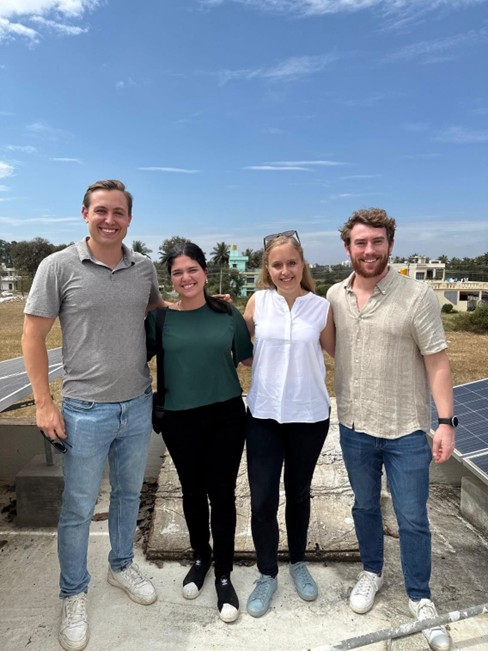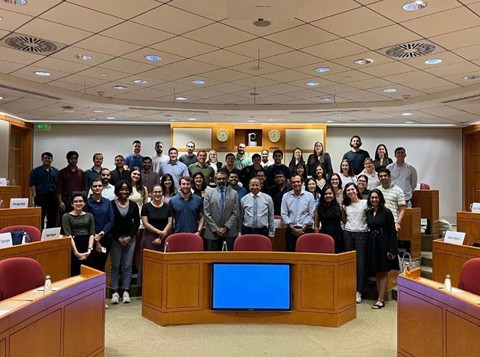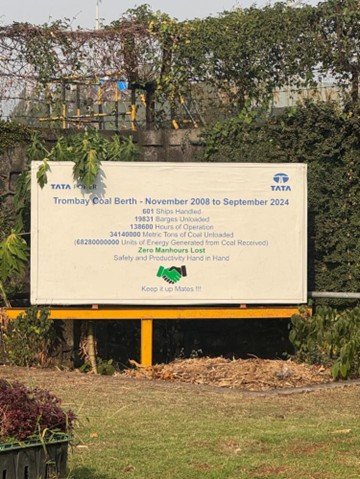Professor Vikram Gandhi’s Immersive Field Course (IFC) “Development while Decarbonizing: India’s Path to Net-Zero" delved into the critical aspect of decarbonization and sustainability goals amid India's rapid development. The course presented an opportunity for students to advance their knowledge of sustainability efforts, decarbonization, and net zero in the context of a broader development agenda. The class culminated in a series of site visits in January 2025 in Mumbai and Bangalore and this is one of 9 student essays that highlights their reflections on uncovering sustainable solutions across the country.
The Coal Dichotomy: Balancing Economic Growth and Decarbonization in India
When you hear the phrase “coal-fired power plant,” what images come to mind? Smokestacks and plumes of soot? Coal dust and blackened equipment? Perhaps you imagine something out of a Dickensian landscape.

For our team, these images were at the forefront of our minds as we touched down in Mumbai to visit Tata Power’s Trombay plant, home to 750 MW of subcritical coal-fired electricity generation. We arrived on January 7th, 2025, with more than just curiosity: we were determined to understand coal’s place in India’s energy future. Specifically, we wanted to resolve a persistent question facing countries around the world: How do you reconcile the urgent need to cut emissions while fueling economic growth and improving livelihoods?
Visiting Tata Power’s Trombay Plant
Our morning began with an in-depth discussion of a new HBS case study on Tata Power. We felt at home at the Harvard Business School Mumbai Center, equipped with a replica of Aldrich Hall’s classroom, where we debated Tata Power’s decarbonization strategy in front of Tata Power CEO, Dr. Praveer Sinha. While Tata Power has committed to making no new investments in fossil fuel energy generation pouring resources into wind, solar, and other renewables instead — the reality is that large swaths of India still depend on coal for electricity.

Following this engaging conversation, our group headed to the Trombay Power Plant to see India’s coal conundrum firsthand. Despite our preconceived images of soot-covered walls, we were startled by the cleanliness and modernity of the facility. Tata Power has invested heavily in technology to limit pollutants like nitrous oxides and sulfur dioxide in addition to equipment designed to minimize creation of coal dust. The plant is heavily automated, improving personal safety and enhancing plant efficiency to 39%, making it almost 20% more efficient than the average coal plant in the United States.1 Finally, the plant boasts plenty of green spaces, including a butterfly garden – certainly not something we expected when we arrived.
Yet behind the veneer, the sobering truth remains: the Trombay Power Plant burns over 5,000 tons of coal daily, emitting between 12–15 megatons of CO₂ each day along with other pollutants inherent to coal combustion. This raises the critical question: how much longer can coal be a part of India’s energy mix — even in its most state of-the-art form?
The Economic Imperative of Coal
India is at an inflection point. The title of our IFC is “Development while Decarbonizing” and we wrestled with how to reconcile the fact that India is one of the fastest-growing major economies in the world and currently the third-largest global emitter of greenhouse gases, yet, on a per capita basis, it remains below the world average of 2 tons per person annually.2,3 The country’s population of over 1.4 billion still relies heavily on coal for electricity, and the demand for energy is only set to increase as more people join the middle class and purchase appliances like air conditioners, washing machines, and refrigerators — technologies that many in the Global North take for granted.
Prime Minister Modi’s government has set ambitious renewable energy targets, aiming to reach 500 GW of renewable energy production by 2030. However, even with those impressive goals, coal still supplies about 70% of the country’s energy needs.4 The tension is clear: India needs to decarbonize for the sake of its people and the planet, but it also cannot afford to jeopardize its economic development.
The social and economic importance of coal in India cannot be overstated. Coal provides some of the cheapest and most readily available baseload power for the country. Also, millions of employees have been performing activities in the coal supply chain for years. Immediate divestment from coal would not only threaten electricity supply to major cities — like Mumbai, where Trombay’s coal units account for roughly 23% of the city’s average daily electricity demand — but would also disrupt industries, cost jobs, and stall development.5

The Environmental Cost: Air Pollution and Climate Risks
In Mumbai, where Tata Power has implemented strong pollution controls at Trombay, the air remains thick with smog, exacerbated by construction dust, vehicular emissions, and nearby industrial activity. Poor air quality, rising temperatures, severe flooding, and intensifying storms disproportionately impact the country’s poorest populations, laying the groundwork for a future public health and humanitarian crisis.
Ultimately, the question is not whether India needs to phase out coal, but how swiftly and responsibly it can do so. The path to a greener future involves managing a delicate balance between meeting energy demands and aggressively scaling up renewables and other low-carbon solutions. The transition requires careful policy planning, massive investments in renewables and grid technology, and social support for communities dependent on coal-related industries. Coal may be necessary now, but it cannot be a part of India’s energy future forever. For a developing nation on the front lines of climate change, harnessing growth while cutting emissions is not just a challenge – it's an imperative.
REFERENCES
1 https://www.pcienergysolutions.com/2023/04/17/power-plant-efficiency-coal-natural-gas-nuclear-and-more/
2 https://www.wri.org/insights/interactive-chart-shows-changes-worlds-top-10-emitters
3 https://www.iea.org/reports/co2-emissions-in-2023/the-changing-landscape-of-global-emissions
4 https://iea.blob.core.windows.net/assets/8a7761ee-4305-42d5-ad5b- 2471c4228772/CoalintheEnergySupplyofIndia.pdf
5 https://timesofindia.indiatimes.com/city/mumbai/tata-powers-trombay-unit-5-year-extension-for-power-supply- needs/articleshow/105607021.cms

